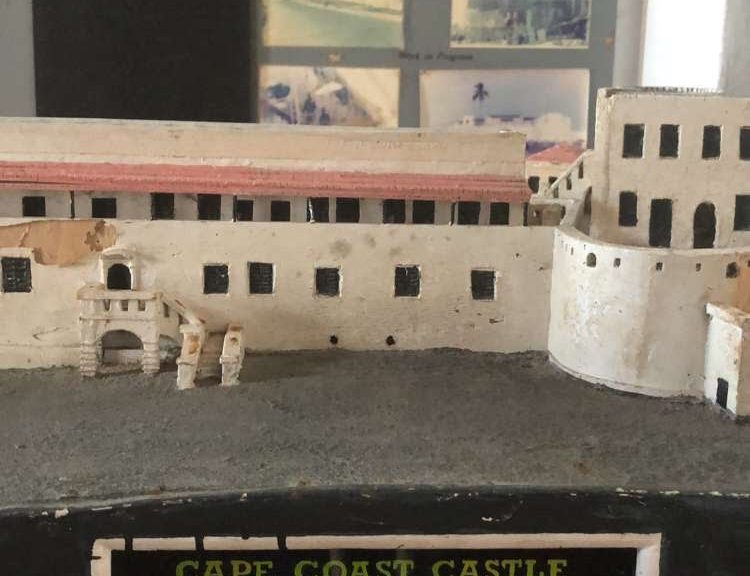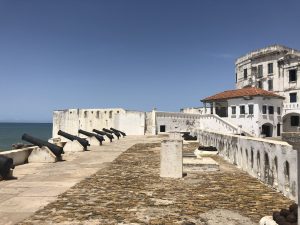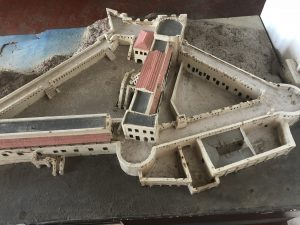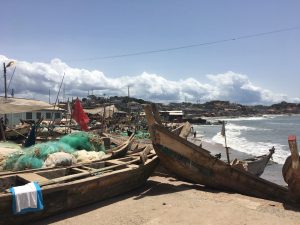
May Their Souls Rest in Perfect Peace
Last weekend, I left Accra for the first time in a while to go to Cape Coast, a mid-size city some 150 kilometers west of the capital. Cape Coast is known to many Africans and oburonis alike for its role in the trans-Atlantic slave trade, but aside from that I found it to be a bright, lively town of merchants and fisherfolk happy to see visitors.
On the rocky shore of the ocean is situated a massive castle, covered in white lime to reflect the hot sun, but weathered from years of salty spray. Hawkers, painters, vendors and their booths line the street leading up to the compound’s entrance. Akwaaba resounds from their mouths at the sight of foreigners. A tour of the property was 40 Ghana cedis for a non-Ghanaian student like myself. The price for a Ghana resident was significantly lower – around 15 cedis for an adult pass. Three of my friends and I joined a tour that had just gotten started. The group was 90% white people. It was the most white people I’ve seen here in one place outside of UG’s campus.
Our tour guide was a young man named Frances who studies at the University of Cape Coast, one of Ghana’s most highly ranked universities. We joined him and the group in the castle courtyard facing the ocean, the parapet lined with rusted black cannons and piles of mortar shells. I squinted as the sun bounced off the whitewashed walls and as mist from the waves blew into my eyes.

Frances spoke with an exacted rhythm and tone that told me he’s done this dozens, maybe hundreds of times before. I followed him practically on his heels as he led us through the courtyard and toward a dungeon entrance. He invited us to put our heads into a 3×3 hole in the wall with a crumbled staircase that led to a dark tunnel. It smelled like must and salt and faintly of ghosts.
If you, dear reader, know nothing of the slave castles that are littered across the “Slave Coast” of Africa, I beg that you soon learn.
Established by the British, the Dutch, the Portuguese, the French, these castles served many purposes for the growing imperial economies of the fifteenth through nineteenth centuries. They housed the European merchant leaders and, later, colonial administrators who supervised imports and exports from major towns along the Gulf of Guinea – Abidjan in Cote d’Ivoire; Lome in Togo; Lagos in Nigeria; Takoradi, Accra, and Cape Coast in the Gold Coast. In exchange for the promise of European trade, the land to build these structures was sold by the African leaders whose people had lived there for generations. They were designed as commercial hubs, defensible forts, and corrals for the human livestock around which trade boomed.

This legacy was in the air that I breathed as I stepped under an arch leading to the female slave dungeons. Like before, I was met with the smell of old dirt, wet rock, and thousands of ghosts spread out across two small chambers. Our wise guide explained how young adult women were kept in these rooms for weeks or months at a time, in total darkness with no air, surrounded by hundreds of their sisters.
Across the castle were the male dungeons, made up of three chambers, deeper underground. Frances bent over and placed his hand against the wall about a foot off the ground where there was a deep stain in the rock. Here, he said, was how deep in shit and vomit hundreds of men had to stand and sleep and eat.
On the south side of the chamber were about a hundred small sculptures of men’s faces carved into stone. Many of them were grimacing, or had their mouths open in shock, or simply looked broken – literally and metaphorically. Frances suddenly asked us to look at the faces. Did they look familiar? Whose faces did we see?

“You might see my face,” he said, as he looked up from the sculptures directly into my eyes.
Whose ghosts were down there? Was it his family? Was it the father of any of the Black Americans I knew back home? People I graduated high school with? These ghosts came from Ghana, sure, but also from Nigeria, and from Benin, and Burkina Faso – maybe even further inland from Mali, or Sudan, or the Congo.
I blinked tears away as I broke eye contact with Frances and with the hundreds of men who stared at me from the dark floor of the chamber.
Upstairs, we faced a huge wooden door painted black with a plaque above reading “Door of No Return.” It was this door which led to the water, where small boats would shuttle captives out to the ships anchored offshore. Countless bodies passed through this door, never to step foot on their mother soil again. Of the twenty million who were led through this door and doors like it across the Slave Coast, only fifteen million survived to see the New World where they would be enslaved (N.B. below).
Five million ghosts, not counting those who died on the march from the inland to the coast, those who died in these dungeons, or those who died on plantations in the Americas. Five million dead not counting their descendants who didn’t survive convict leasing in the coal mines, or the Jim Crow South, or the prison-industrial system of today.
I felt all these souls as I left the castle. My skin, white as the walls that were beaten by the waves, crawled.

Examining my position as an American who has inadvertently benefited from the stolen labor of these bodies, I am humbled, humiliated, and somber. I am privileged enough to know where my ancestors came from. I know the names given to them at birth by their people. My ancestors were not doomed to a fate such as this – snatched from their homes, forced to walk hundreds of kilometers to be shipped thousands more kilometers across the sea, and given names foreign to their tongues. Of all the benefits I reap from the color of my skin, this is perhaps the most heart-wrenching. To my Black American sisters and brothers back home, I weep with you at the number of souls lost to the slave trade.
But more importantly, I will fight with you to get back what was stolen, to hold accountable those who devalue your lives and your labor to this day. Africans and oburonis alike – we, the living – vow to uphold this.

N.B. There is much disagreement on the exact number of people captured from Africa and brought to the Americas, due to inadequate primary materials from the slave traders. Twenty million captives is generally the lowest estimate. Most agree, however, that of the millions who embarked on the Middle Passage, anywhere from 10-20% of them died on the journey. For more information on the particular controversies surrounding the historiography of the trans-Atlantic slave trade, see Walter Rodney, How Europe Underdeveloped Africa (Panaf Publishing: Abuja) 2009 ed., especially pp. 108-120.
For further reading on the African Diaspora, especially from a Ghanaian-“American” perspective, I highly recommend Yaa Gyasi’s debut novel Homegoing (Knopf: New York, 2016).
Additionally, the literature of Ta Nehesi-Coates and James Baldwin provide insights on the contemporary experiences of Black men in America as they have been shaped by America’s legacy of institutionalized racism.